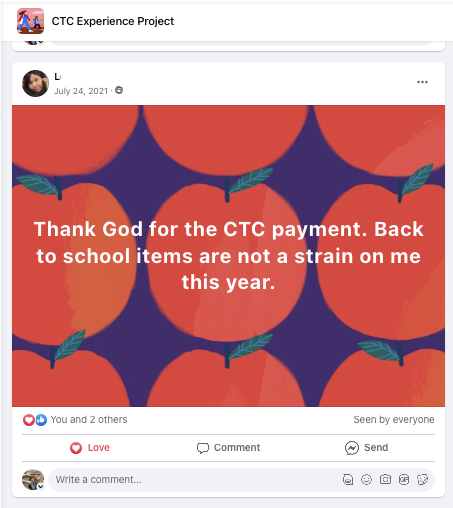CASE STUDY
Expanded Child Tax Credit Experience
June 2021 - April 2022
Propel
Role
Co-project lead, User researcher
Team
Kaela Gallo, Julieta Cuéllar
About the Organization
Propel is a social impact software company, and creators of the Providers app, a free mobile app that helps 5+ million EBT cardholders manage their benefits, access free mobile banking, save money, and earn income.
Context
The American Rescue Plan Act (ARPA), enacted in March 2021, transformed the existing Child Tax Credit into a nearly universal, monthly cash benefit for families with children under 18. Instead of one lump sum at tax time, ARPA advanced half of the Child Tax Credit (CTC) in monthly payments; increased the maximum credit per child; and expanded it to include families that earned little or no income. With this change, most American families with children under 18 received monthly payments ranging from $250–300 per child, depending on their child’s age. The majority of the Providers app population was eligible for this additional credit.
While the CTC reached most American families with children under 18, we anticipated its impact would be deepest both materially and psychologically among the families living on the lowest incomes.
We believed that most research would be focused on the quantitative financial impact of the CTC. As Providers serves one-quarter of the total SNAP households in the United States, we hoped that our qualitative research would humanize the numbers and bring nuance to the impact of this monumental and temporary change in policy.
Intent
We hypothesized that the additional monthly income would make a positive impact on households’ well being. If our hypothesis proved to be correct, we hoped that our findings would influence future policy and advocate for the value of the CTC.
Impact
We detailed our findings on the Propel blog and regularly shared insights with non-profit and government partners. While our research did not directly influence a continued expanded CTC, it did continue the conversation.
Our findings:
allowed us to advocate for improved user experience of government programs
provided a platform for our research participants to share their stories about financial security.
strengthened Propel’s status as a go-to source for understanding low-income households’ experiences.
The federal expanded Child Tax Credit did not live beyond it’s initial expansion, but advocates across the country hope that the conversation will resurface as more communities explore Universal Basic Income (UBI) and other programs. Many states, like Colorado, are already iterating on existing policy design. In fact, in February 2023, President Biden called on Congress to bring back the expanded Child Tax Credit in his State of the Union Address. We hope that someday this life changing benefit will become a permanent policy.
Methods
8-month longitudinal study following 10 families
Monthly survey at the time of the expected deposit
Capture deposit timeliness, amount, method of receipt, and other specific details about the month’s CTC payment
Monthly 30-minute semi-structured interview conducted in English and Spanish
Understand how families spent the payment, and what else was going on in their lives as a direct or indirect result of the payment
Closed Facebook group for interim communications
This research was complimented by a separate quantitative longitudinal survey. Conducted in partnership with University of Michigan (published paper), this survey measured Providers households’ well being each month.
Selected Findings
More money had a positive impact on every family.
Many of the families we spoke with were skeptical of the payments, distrustful that they would come regularly or dubious of how much they could rely on the money. But in the months that followed, we bore witness to the small and big moments where the money made a difference.
About the participant families
When recruiting for this project, we sought to speak with families from a wide variety of experiences and economic situations.
Ages 26 to 46
9 states
2 native Spanish speakers
7 working full or part time
1 to 4 children
4 single parents households
9 lived in rented or public housing.
Average monthly CTC payment: $635
“[The CTC] really lightens the burden of taking care of children because providing for their needs is expensive. They always need something, you know, new clothes or feet are expanding. You need new shoes. You don’t want to send your children any type of way to school.”
- Gwendolyn*, a mother of two in Georgia
But families with greater stability saw the greatest impact.
We started to see, as the months went on, that the impact of the monthly payments depended on how stable the family’s situation was before the first CTC deposit.
As is common with most households living on lower incomes, month-to-month finances can be manageable until one emergency or unexpected expense throws off the balance. When that happens, it can take months or years to recover.
Families who didn’t get their monthly payments, struggle was the status quo.
Despite being eligible, Adela* didn’t receive a single cent of her CTC payments until she filed her taxes in March 2022. A single mother of an autistic son, Adela’s husband died unexpectedly in 2020. In the middle of years’ long battle with cancer, Adela started working nights to pay rent and spent the days caring for her son. Had she received her monthly CTC payments, she could have avoided using credit to pay for her cancer medication, get more rest to battle her illness, and be there for her son more often at night.
Families who had steady income pre-CTC, the monthly deposit turned what could have been emergencies into manageable events.
Venessa*, who works full time as a warehouse worker, lives with her two toddlers and her husband, who’s a stay-at-home dad. Venessa missed a week of work due to illness after getting the COVID-19 vaccine. The $600 CTC payment took the pressure off of missing a week of work. It allowed her to recover, and she did not have to miss out on important family time to make up for the missed wages with extra hours in the following weeks.
Families that had stable employment were able to fulfill their dreams.
While they were doing well enough to get all the bills paid before the CTC payments, there was little or no wiggle room to get ahead.
Charlotte*, a long-time state employee and a single mom of two teenagers, dreamed of owning her own house but a low credit score stood in her way. With the latitude provided by the CTC payments, she could cover her kids’ school costs and sports uniforms, as well as pay for a service to improve her credit score. In less than a year, the monthly CTC payments helped her turn improve her credit and get approved for a mortgage.
The experience of receiving the advance CTC payments affected its impact on families.
Families in our project had many experiences with government systems before the CTC. Like many other low-income families, they had little trust in the government, and the IRS in particular, due to previous negative experiences and the lack of transparency that comes with many government systems and decisions. Lack of trust in the system manifested in different behaviors among the families we followed.
By September 2021, Holly* had called the IRS “at least 50+ times” in the past year to figure out why she hadn’t received the first 2 stimulus payments. She kept detailed notes of every call, including agent ID numbers, but received no answers as to why she’d gotten the advance CTC payments but not these stimulus payments. If she had received this money when she was owed, she’d have less than $1,000 left to pay on her home.
To read the full set of insights, see the Propel blog post: 10 Families Across 8 months: Studying the Impact of the Child Tax Credit on Providers App Users






